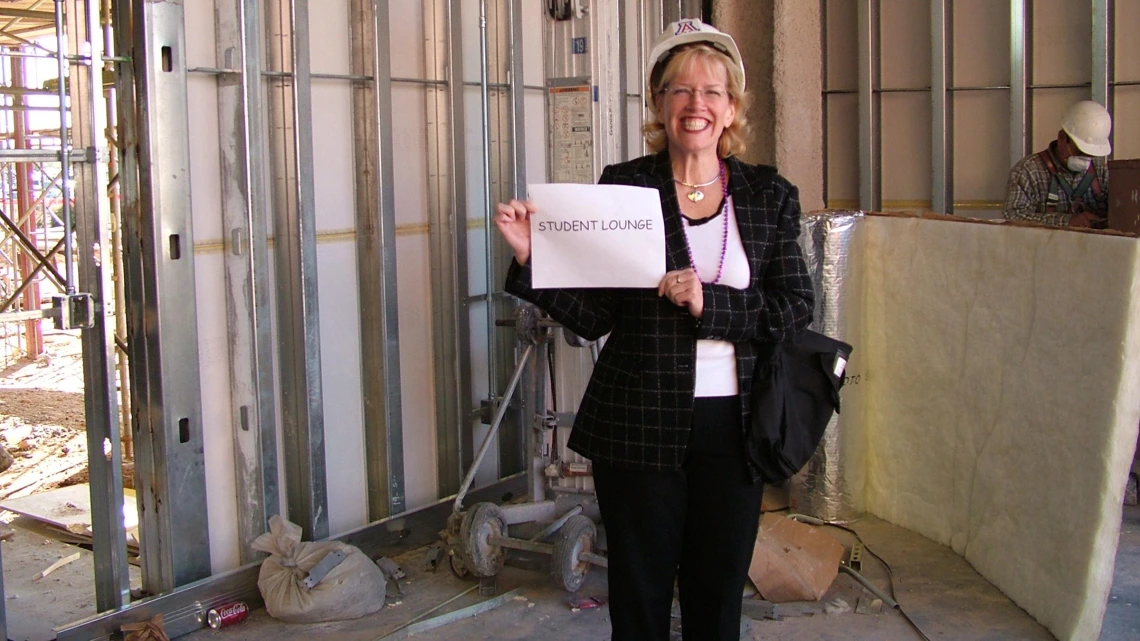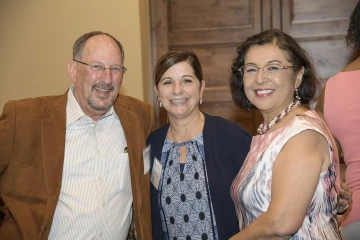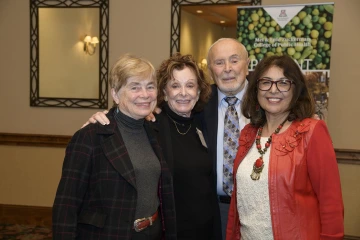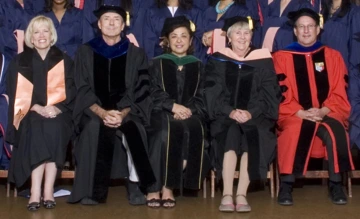Public Health ‘Originals’ Reflect on the Past Two Decades
The College of Public Health honors its ‘MEZCOPH Originals,’ faculty and staff who have been with the college since its inception in 2000.

Chris Tisch takes a tour of Roy P. Drachman Hall under construction in 2005. Tisch is one of a small number of staff who have been with the Mel and Enid Zuckerman College of Public Health since its inception in 2000.
As the Mel and Enid Zuckerman College of Public Health celebrates its 20th anniversary, the occasion has prompted several faculty and staff who have been with the college since the beginning to reflect on their experiences.
A few of the “MEZCOPH Originals” take us on a walk down memory lane (see full list at end of story).
A long ‘gestation period’
The Mel and Enid Zuckerman College of Public Health has come a long way in the past two decades, but the early concept for the college dates back to 1991, when the College of Medicine began awarding master’s degrees and doctorates in epidemiology. A Master of Public Health program quickly followed, launched in 1993 when the Arizona Board of Regents approved the establishment of the Arizona Graduate Program in Public Health, housed in the medical school.
Chris Tisch, now assistant dean of student and alumni affairs, calls that period in the ’90s the college’s “gestation period.”

Robin B. Harris, PhD, MPH
“I’m amazed at how quickly the time has gone by,” Tisch recalled. “Colleagues and students who were having babies in the early days are now taking those kids to college! How can that be?”
Robin B. Harris, PhD, MPH, professor of public health in the Department of Epidemiology and Biostatistics, also remembers this transformation.
“In 1994, I began teaching the Epidemiology A and B courses in the Graduate Program in Epidemiology and the MPH program,” Dr. Harris said. “I well remember the first time I went in front of a class of more than 70 Basic Principles of Epidemiology students in 1994. I was only five minutes ahead of them. I thank all the students over the years (probably well over 3,000) who have helped me learn a lot of epidemiology! All of these students have taught me lessons, and I think I am a far better teacher, and person, for those interactions.”
Dr. Harris said the students are at the heart of all the college does.
“I have talked about retiring for over five years, but I keep staying on to work with students and conduct a wide range of research with great colleagues, strong community partners and students all around.”
Adolescent growing pains
The small program would soon outgrow its small corner in the College of Medicine’s Department of Family and Community Medicine, and the need for a more robust public health program weighed heavily.
“We started as a small group of individuals who strongly believed that the University, and Arizona, needed a College of Public Health,” Dr. Harris said. “There were incredibly few resources available at the time, but the group believed that we could make it happen. Arizona needed public health commitment.”

Douglas Taren, PhD; Cynthia Thomson, PhD, RD; Dean Iman Hakim, MD, PhD, MPH
That call was heeded in 1997, when Canyon Ranch founders Mel and Enid Zuckerman pledged $10 million toward what is now the only nationally accredited college of public health in the Southwestern United States. Officially established by the Arizona Board of Regents in 2000, the College of Public Health received accreditation in 2003.
“Initially, our students were from Arizona and the Southwest, and now we have a national and international student body,” said Douglas Taren, PhD, professor and director of the Western Region Public Health Training Center, and one of the “Originals” who created the university’s first MPH program at the College of Medicine. “As a program with less than 20 students, it has grown to several hundred graduate students and 1,000 undergraduate students.”
Coming of age as a college
The college was officially named after Mel and Enid Zuckerman in 2002, and the next year construction began on Roy P. Drachman Hall, named after a major university benefactor who spearheaded the project’s fundraising. It was the first academic building on the UArizona Health Sciences campus in Tucson, north of Speedway Blvd., in 20 years.

Former Dean G. Marie Swanson, PhD, MPH; Enid Zuckerman; Mel Zuckerman; Dean Iman Hakim, MD, PhD, MPH
“In the early 2000s, we were scattered among a few houses and the Cancer Center, and the administration was on the fourth floor of the College of Medicine building,” said Dean Iman Hakim, MD, PhD, MPH. “My office was in a small house on Elm Street, and then I moved to the second floor of new Cancer Center building.”
The new Roy P. Drachman Hall would bring public health students from across 22 locations on and off campus together under one roof. Drachman Hall was dedicated in 2006.
“Getting a new building brought us together and made us feel and act like a college,” Dr. Taren recalled.
“Watching Drachman Hall go up was pretty amazing,” Tisch said.
Becoming an international leader in public health
The college has seen its mission expand over the past two decades, educating students from undergraduate through doctoral studies, advancing science through research and making a difference in the state’s diverse communities.
Six ways the college has grown:
1. Number of faculty has tripled
2. Research expenditures have more than doubled in the last 10 years
3. New campus in Phoenix
4. New undergraduate degree and new doctoral degrees
5. Four new online degree programs
6. New global education programs
“Every aspect of the college seems to have blossomed,” Tisch said. “Our academic programs have diversified, we’ve hired faculty whose research careers have taken off, and we are known far and wide for our community outreach. Under each leader, we’ve expanded the college’s portfolio. I get tickled when I introduce myself as being from MEZCOPH and receive complimentary and congratulatory comments. We have arrived!”
Looking ahead
“Today we stand as a recognized leader in public health. We have grown the college into an ecosystem of centers and programs, research and education, promotion and outreach that has improved health and wellness for millions of people,” said Dr. Hakim.
The pandemic has further highlighted the college’s mission and goals for a growing number of people around the world, and has made clear the critical role it has in responding to a devastating public health crisis. Its work varies from epidemiological research to inform public policy decisions, to outreach activities to promote public safety practices, to creating toolkits and technology to inform personal wellness and health decisions.

“Originals” at 2009 convocation, from left: Chris Tisch; Duane Sherrill, PhD; Dean Iman Hakim, MD, PhD, MPH; Jill de Zapien, Douglas Taren, PhD.
“In the midst of the most challenging pandemic of our lifetime, people now recognize that the impact of public health programs is both global and personal,” Dr. Hakim said. “This crisis has helped the community expand its definition and views of public health. Because we’ve led with both cutting-edge science and deep community commitments, I’m confident there will be remarkable changes on the horizon for the field of public health.”
The “Originals” say their daily inspiration remains rooted in the people who make the college a great place to work, teach, study and contribute to a healthier world.
“I’ve learned that when you have a group of dedicated, hard-working, well-intentioned, great people on your team, there is no limit to the challenges you can meet and the goals and objectives you can accomplish,” Tisch said. “My biggest inspiration has been and will always be the college’s amazing students, who transform into awe-inspiring alumni. Their devotion to the public health mission and to making the world better in so many ways makes my heart sing.”
Photo Gallery: Meet the Public Health ‘Originals’

